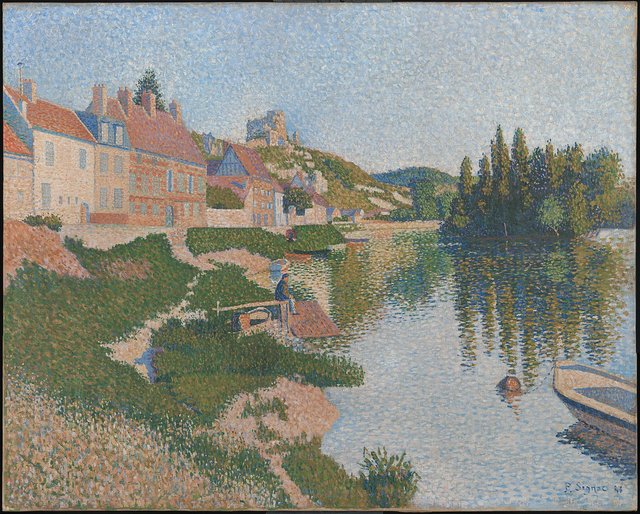A Stroke Of Genius: Paul Signac
Neo-Impressionist artist Paul Signac was born in Paris, France on the 11th of November, 1863. He is known for his many paintings of the French coast and developing the Pointillist style, alongside Georges Seurat.

Saint Tropez Fontaine des Lices, 1895, www.commons.wikimedia.org
-Pointillism is a painting technique where small and distinctive dots of colour are applied in a pattern to form an image.
-Divisionism is another term used in Pointillism. It is a Neo-Impressionist style of painting where colours separate into individual dots or strokes of pigment.

Snow Boulevard de Clichy Paris, 1886, www.commons.wikimedia.org
Before he chose a career in painting, Signac was taking a course in architecture. He knew he wanted to paint after attending a Monet exhibition. He began his journey into Impressionism.
In the year of 1884, Signac met Monet and Seurat. When he was introduced to Seurat's methods and colour theory, Signac quickly abandoned Impressionism and began experimenting with what Signac and Seurat would then call Pointillism. On July 29th in 1884, Signac, as well as Georges Seurat, Odilon Redon, Albert Dubois-Pillet and others founded the Société des Artistes Indépendants or Salon des Indépendants, Paris' annual art exhibition that still goes on today.

Le Bouee Rouge, 1895, www.commons.wikimedia.org
In 1886 in Paris, Signac met Van Gogh. On a regular basis in 1887, the two artists took trips to Asnières-sur-Seine and painted what they saw.
Several years later, Signac sailed the Mediterranean Sea and painted the landscapes he encountered along the European coastlines. One of his favorite subjects to paint was the water.

The Jetty at Cassis Opus, 1889, www.commons.wikimedia.org
In 1905, Henri Matisse's Luxe, Calme et Volupté exhibited at the Salon, the famous painting that Dufy witnessed that struck his interest in Fauvism.
%201905%20wikimedia.jpg)
Grand Canal, Venice, 1905, www.commons.wikimedia.org
During the same year of his sailing expedition, Signac married Berthe Roblès in 1892 where artist Camille Pissarro would be one of the witnesses.
In 1908, Signac was appointed as president of the Salon des Indépendants. He remained the president until his death.
Many years later, still-married Signac got an apartment with one of his art students Jeanne Selmersheim-Desgrange who was also married. She gave birth to their daughter in 1913. Signac and Roblès remained friends for the rest of his life.

Les Andelys, 1923, www.commons.wikimedia.org
In 1919, the Prix Blumenthal was created, a grant which was awarded to artists and Signac served as a juror for the grant with its creator Florence Meyer Blumenthal.
Signac died of sepsis on August 15th, 1935.
Although, Signac isn't the first person you think of if asked about that time period of art but he is one of the most important people during the Neo-Impressionism movement. He was one of the founders of Paris' biggest art exhibition. He developed an art technique that is so unique and fascinating.
You surely have to have an eye for detail and a steady hand to use such a technique in your work. I can't image the amount of hours and patience it took to complete a single painting. Or, the amount of time he stood or sat in the same spot. But, no matter the time it took, Signac created amazing paintings. The amount of incredible detail within the images was attained solely by using dots of pigment. It's remarkable.